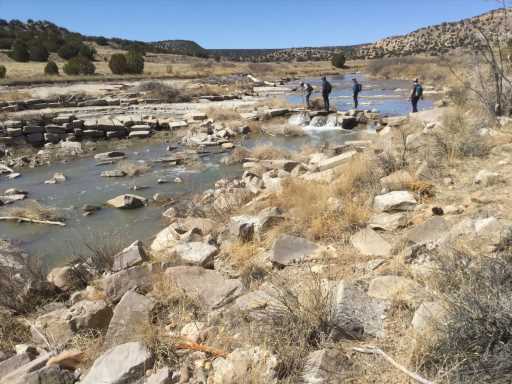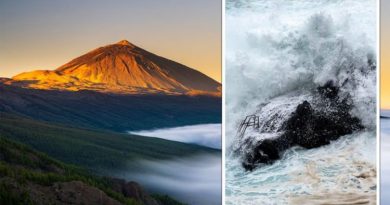A Colorado hike to the largest dinosaur trackway in North America
Eleven-plus miles is a long hike, but seeing the largest dinosaur trackway in North America in the Comanche National Grassland in remote southeastern Colorado had been a goal for a while.
So when Trinidad’s Fishers Peak Outfitters organized a group trek to the Picket Wire Canyonlands in April, I was all in. Carlos and Leigh López opened their outdoor store two years ago and offer two outings a month in southern Colorado. Another dinosaur track trek is set for Oct. 14.
We carpooled for the 1.5-hour drive from Trinidad, half on dirt roads, to the Withers Canyon Trailhead the night before, where 30 mph-plus winds made setting up tents challenging.
For Leigh, the drive through the sparse grasslands belies what later unfolds.
“I really think it’s a really beautiful place that’s not going to be what you think it’s going to be,” said Leigh. “When you are driving out there you just see flat all around you and then all of a sudden you are in the canyon, it’s kind of vast and beautiful and you see the cliff walls.”
Driving with wind-driven dust obscuring your view for brief moments reminds you that the Comanche National Grassland was established in 1960 when the government placed the recovered lands from the 1930s dust bowl era under the management of the U.S. Forest Service.
The Grassland, roughly half the size of Rhode Island, “is managed to conserve and use the natural resources of grass, water and wildlife habitat and to protect prehistoric and historic areas,” according to the Grassland website.
Fortified with coffee against temperatures in the 30s, our group of nine sets out at 8 a.m. hiking about 250 feet down into the canyon, where we follow the Purgatoire River 5 1/2 miles to the track site. Afternoon temperatures that day were probably in the low 80s.
Tyler and Lindsay Barnett of Trinidad opted for different ways to the tracks, with Lindsay on foot and Tyler mountain biking beyond the tracks to the historic Rourke Ranch that dates from 1871.
“I just loved how remote it is,” Tyler said. “I think I passed one person the entire time that wasn’t in our group. It was totally worth it, but definitely be prepared for all the flats because of all the goatherds down there.” On a prior biking trip, Tyler spotted a bobcat.
You are going down into a canyon that will take you 150 million years back in time to the Jurassic Period, but before they get there our time travelers get a close-up of other eras.
Remote settlement in the canyon
Amidst the cactus remnants from those who once settled this canyon are scattered along the route. A rusting stove lays just off the dusty trail near the ruins of a homestead — dreams of a new life cut short by the harsh environment.
Farther along, we encounter the Dolores Mission ruins with the adjacent cemetery.
After the Mexican-American War ended, a group of Mexican immigrants led by Damascio López that included 11 families “established the first permanent settlement in the canyon lands,” according the Grassland website.
At first, the community was without a local priest or church.
“In 1898, Damascio sold 0.11-acres of his land to the Denver Diocese for $1.00. The community then built a church called the Dolores Mission,” the website said.
Our group stopped to inspect the graveyard’s headstones with one indicating a child lived for one week.
“I just know they had a lot of children that didn’t make it and you see a lot of those tombstones of young people that lived in these harsh, harsh conditions that just is a testimony to people’s perseverance and their ability to try things that are … so challenging and just how people would relocate their families down there, it just shows the human spirit at its fullest,” Carlos López said in a recent interview.
The canyon yields more clues of earlier times with Native American petroglyphs including designs of hands and figures etched into rock slabs.
“You think about how the Native peoples have been in that canyon for thousands and thousands of years and made all that artwork on the rocks,” noted Leigh.
For Carlos, the petroglyphs are one of the most interesting aspects of the trek.
“I love the petroglyphs,” he said. “It think it just leaves the mind to wander as to what these primitive people were thinking when they were creating these artistic memoirs of sorts that are left behind for everyone to kind of speculate on.”
Lunch surrounded by dinosaur ghosts
After about 2 1/2 hours, we reach the tracks and cross the river on stepping stones to break for lunch and explore.
Along both sides of the river there are about 1,900 footprints representing 130 trackways that extend almost a quarter-mile, according to the Forest Service.
Interpretive signage states that while today’s Purgatoire River winds through a rugged and arid landscape at the time several different types of dinosaurs left their mark, the land was a vast shallow lake with a conifer forest and ferns. Those dinosaurs included the plant-eating Brontosaurus and meat-eating Allosaurus.
The herds left their footprints in mud, which was later sunbaked and then turned to stone. The river’s waters revealed the tracks and now those same waters are starting to erode them, but the Forest Service uses erosion control structures to preserve the site.
Carlos López wondered what else might be hidden.
“I’m wondering what else is under there that they haven’t exposed because it’s a pretty large site but you know if you keep digging you are going to find more. But I think they have left it that way to preserve them. But they are ever-changing because of the way the water flows through there.”
Serious precautions needed: no potable water, no cellphone coverage
The Picket Wire Canyonlands is a serious place as the warning signs indicate. Two people died here in 2017 within a half-mile of the trailhead.
“Turn around before your water is one-half gone,” states one sign. “Hiking into the canyon is OPTIONAL, hiking out of the canyon is MANDATORY,” says another.
A couple recently inquired about hiking there, said Leigh López.
“I advised against going in the summer months. It’s way too hot down there,” she said. “When you get into that canyon it can get really warm really fast and there is not a lot of tree cover, there is not a lot shade.”
Drink and take plenty of water, she advised. “It’s not a hard trek but it is a long trek.”
The Forest Service advises to leave early and take at least gallon of water per person.
If you go
Fishers Peak Outfitters, Trinidad; fisherspeakoutfitters.com; 719-422-8223; 304 Main St., Trinidad, CO. Comanche National Grassland administered by the U.S. Forest Service; 1420 East Third St., La Junta, CO.; 719-384-2181. Hiking, biking and equestrian use but no overnight camping in the canyon. Guided auto tours are available every Saturday during May, June, September and October. www.recreation.gov or 877-444-6777.
Subscribe to our weekly newsletter, The Adventurist, to get outdoors news sent straight to your inbox.
Source: Read Full Article







